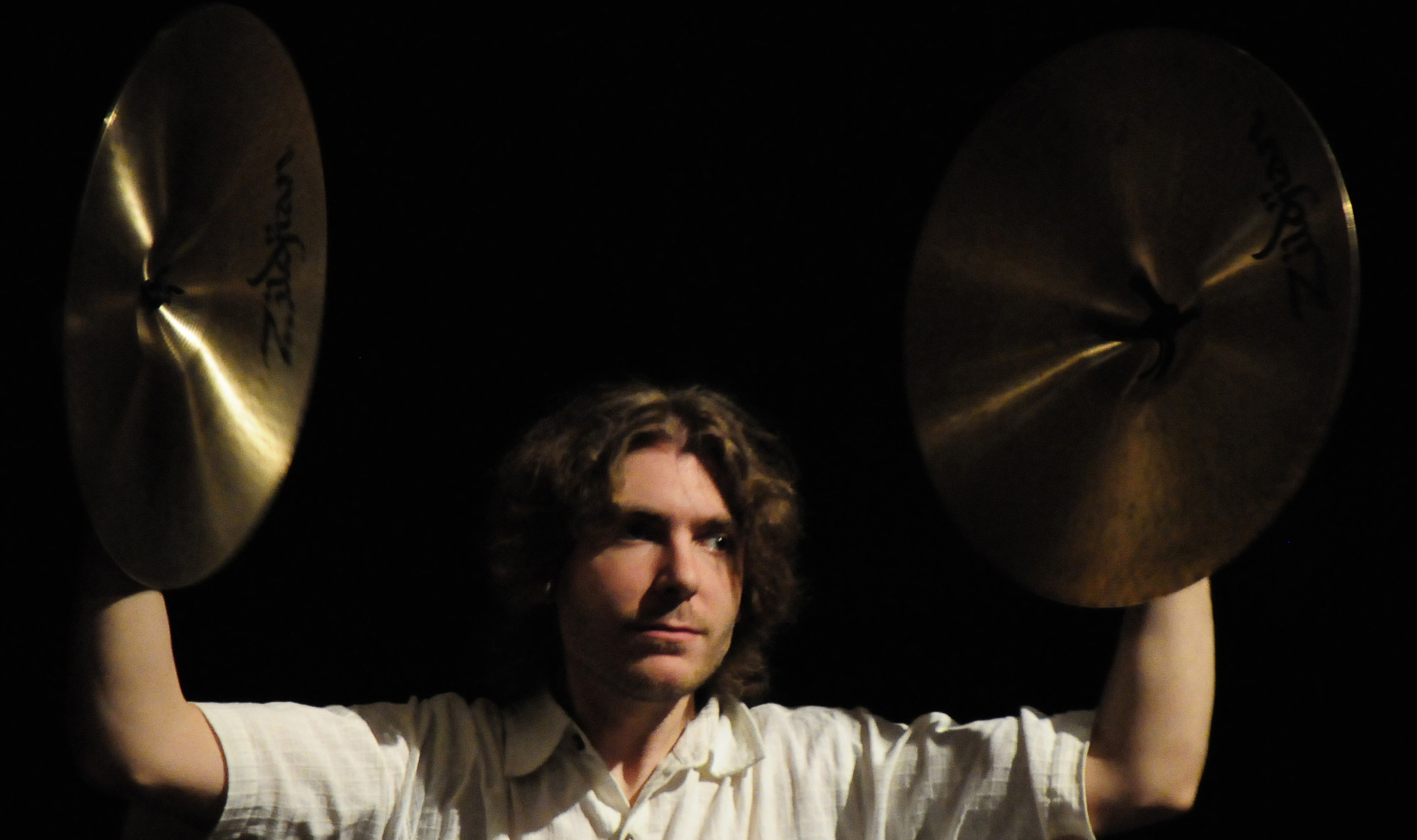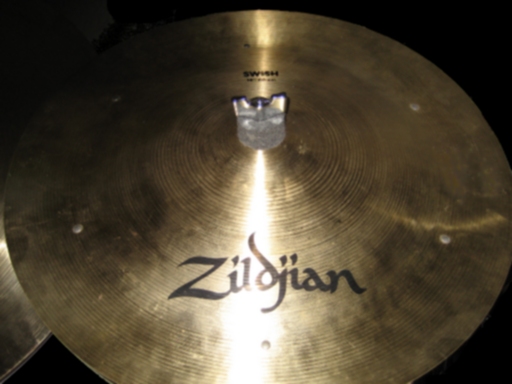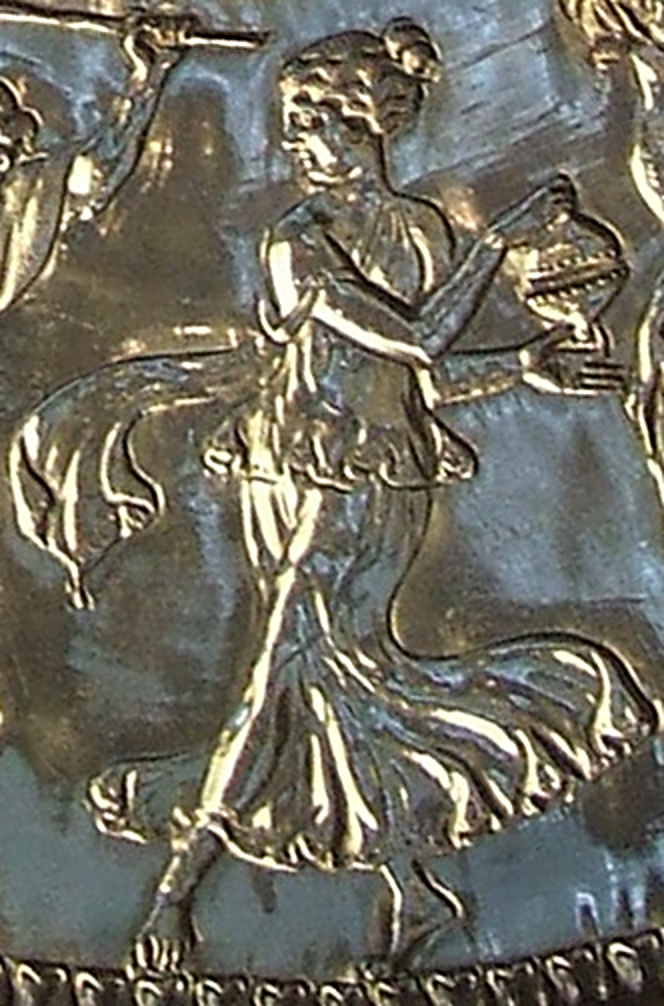|
Cymbal
A cymbal is a common percussion instrument. Often used in pairs, cymbals consist of thin, normally round plates of various alloys. The majority of cymbals are of indefinite pitch, although small disc-shaped cymbals based on ancient designs sound a definite note (such as crotales). Cymbals are used in many ensembles ranging from the orchestra, percussion ensembles, jazz bands, heavy metal bands, and marching groups. Drum kits usually incorporate at least a crash, ride, or crash/ride, and a pair of hi-hat cymbals. A player of cymbals is known as a cymbalist. Etymology and names The word cymbal is derived from the Latin ''cymbalum'', which is the latinisation of the Greek word ''kymbalon'', "cymbal", which in turn derives from ''kymbē'', "cup, bowl". In orchestral scores, cymbals may be indicated by the French ''cymbales''; German ''Becken'', ''Schellbecken'', ''Teller'', or ''Tschinellen''; Italian ''piatti'' or ''cinelli''; and Spanish ''platillos''. Many of these deri ... [...More Info...] [...Related Items...] OR: [Wikipedia] [Google] [Baidu] |
Drum Kit
A drum kit (also called a drum set, trap set, or simply drums) is a collection of drums, cymbals, and other auxiliary percussion instruments set up to be played by one person. The player ( drummer) typically holds a pair of matching drumsticks, one in each hand, and uses their feet to operate a foot-controlled hi-hat and bass drum pedal. A standard kit may contain: * A snare drum, mounted on a stand * A bass drum, played with a beater moved by a foot-operated pedal * One or more tom-toms, including rack toms and/or floor toms * One or more cymbals, including a ride cymbal and crash cymbal * Hi-hat cymbals, a pair of cymbals that can be manipulated by a foot-operated pedal The drum kit is a part of the standard rhythm section and is used in many types of popular and traditional music styles, ranging from rock and pop to blues and jazz. __TOC__ History Early development Before the development of the drum set, drums and cymbals used in military and orchestral m ... [...More Info...] [...Related Items...] OR: [Wikipedia] [Google] [Baidu] |
Splash Cymbal
In a drum kit, splash cymbals are the smallest accent cymbals. Splash cymbals and china cymbals are the main types of effects cymbals. The most common sized splash has a diameter of 10", followed by 8". Most splash cymbals are in the size range of 6" to 13", but some splash cymbals are as small as 4". Some makers have produced cymbals described as ''splash'' up to 22", but a splash of 14" or more is more often described as a crash cymbal. Splash cymbals include: * Traditional splash cymbals, medium in weight with little or no taper. * Rock splash cymbals, heavy but often with a slight taper. * China splash cymbals. * Salsa splash cymbals. * Thin splash cymbals. * Bell cymbals. * Specialised ''stack'' cymbals. History The original and traditional ''splash'', like many of the cymbal types in a drum kit, was invented and named by Gene Krupa in collaboration with the Avedis Zildjian Company. Widely used in the jazz music of the 1920s and 30s, this traditional splash cymbal was not ... [...More Info...] [...Related Items...] OR: [Wikipedia] [Google] [Baidu] |
Hi-hat (instrument)
A hi-hat (hihat, high-hat, etc.) is a combination of two cymbals and a pedal, all mounted on a metal stand. It is a part of the standard drum kit used by drummers in many styles of music including rock, pop, jazz, and blues. Hi-hats consist of a matching pair of small to medium-sized cymbals mounted on a stand, with the two cymbals facing each other. The bottom cymbal is fixed and the top is mounted on a rod which moves the top cymbal toward the bottom one when the pedal is depressed (a hi-hat that is in this position is said to be "closed" or "closed hi-hats"). The hi-hat evolved from a "sock cymbal", a pair of similar cymbals mounted at ground level on a hinged, spring-loaded foot apparatus. Drummers invented the first sock cymbals to enable one drummer to play multiple percussion instruments at the same time. Over time these became mounted on short stands—also known as "low-boys"—and activated by pedals similar to those used in modern hi-hats. When extended upward roug ... [...More Info...] [...Related Items...] OR: [Wikipedia] [Google] [Baidu] |
Hi-hat
A hi-hat (hihat, high-hat, etc.) is a combination of two cymbals and a pedal, all mounted on a metal stand. It is a part of the standard drum kit used by drummers in many styles of music including rock, pop, jazz, and blues. Hi-hats consist of a matching pair of small to medium-sized cymbals mounted on a stand, with the two cymbals facing each other. The bottom cymbal is fixed and the top is mounted on a rod which moves the top cymbal toward the bottom one when the pedal is depressed (a hi-hat that is in this position is said to be "closed" or "closed hi-hats"). The hi-hat evolved from a "sock cymbal", a pair of similar cymbals mounted at ground level on a hinged, spring-loaded foot apparatus. Drummers invented the first sock cymbals to enable one drummer to play multiple percussion instruments at the same time. Over time these became mounted on short stands—also known as "low-boys"—and activated by pedals similar to those used in modern hi-hats. When extended upward roug ... [...More Info...] [...Related Items...] OR: [Wikipedia] [Google] [Baidu] |
Clash Cymbals
Clash cymbals (also called concert cymbals, orchestral cymbals, or crash cymbals) are cymbals played in matched pairs by holding one cymbal in each hand and striking the two together. To differentiate this type of cymbal from a suspended cymbal, they are also called hand cymbals. Terminology In Sheet music, musical scores, clash cymbals are normally indicated as ''cymbals'' or sometimes simply ''C.C.'' If another type of cymbal, for example a suspended cymbal, is required in an orchestral score, then for historical reasons this is often also indicated ''cymbals''. Some composers and arrangers use the plural ''cymbals'' or ''crash cymbals'' to indicate clash cymbals, with the singular ''cymbal'' to indicate a suspended cymbal. Composers will often condense the clash cymbals and a suspended cymbal into the same part. There are a number of techniques used to indicate which is desired. Whenever ''with stick'' or ''with mallet'' is written, a suspended cymbal is used. A return to clas ... [...More Info...] [...Related Items...] OR: [Wikipedia] [Google] [Baidu] |
China Cymbal
China type cymbals from three continents In western music, a China cymbal (or Chinese cymbal) is a distinct type of crash cymbals designed to produce a bright, crisp, and explosive tone. It is for this reason that they have been nicknamed "''trash cymbals''". The name "China cymbal" comes from their shape, which is similar to the Chinese Bo. They are most frequently mounted upside down on cymbal stands, allowing for them to be more easily struck and for a better sound. China-type cymbals are mostly commonplace in various interpretations of rock music, particularly heavy metal and thrash metal. It is also frequently used for jazz fusion, Latin, and Brazilian music especially those with elaborate drum solos. In Latin and several world music, China cymbals are usually played in conjunction with other percussion instruments instead of a drum kit, such as timbales, octobans or surdo. China cymbals may also be used for conventional jazz, often played with mallets or brushes to achiev ... [...More Info...] [...Related Items...] OR: [Wikipedia] [Google] [Baidu] |
Ride Cymbal
The ride cymbal is a standard cymbal in most drum kits. Its function in the kit is to maintain a beat,Schroedl, Scott (2001). ''Play Drums Today!'', p.7. Hal Leonard. . "It's called the ride cymbal because you 'ride' on it--that is, you maintain a steady pattern." sometimes called a ride pattern, rather than the accent of a crash. It is normally placed on the extreme right (or dominant hand) of a drum set, above the floor tom.Peckman, Jonathan (2007). ''Picture Yourself Drumming'', p.195. . The ride can fulfill any function or rhythm the hi-hat does, with the exception of an open and closed sound. The ride is played with a drumstick. Terminology The term ''ride'' means ''to ride with the music'', describing the cymbal's sustain after it is struck. The term may depict either the function or characteristic of the instrument. Most cymbal makers manufacture specific cymbals for the purpose. Some drummers use a china cymbal, a sizzle cymbal or a specialized tone such as a swish o ... [...More Info...] [...Related Items...] OR: [Wikipedia] [Google] [Baidu] |
Crash Cymbal
A crash cymbal is a type of cymbal that produces a loud, sharp "crash" and is used mainly for occasional accents, as opposed to a ride cymbal. It can be mounted on a stand and played with a drum stick, or by hand in pairs. One or two crash cymbals are a standard part of a drum kit. Suspended crash cymbals are also used in bands and orchestras, either played with a drumstick or rolled with a pair of mallets to produce a slower, swelling crash. Sometimes a drummer may hit two different crash cymbals in a kit at the same time to produce a very loud accent, usually in rock music. Although crash cymbals range in thickness from paper-thin to very heavy, all crash cymbals have a fairly thin edge. They are typically in diameter, but sizes down to and up to are manufactured. Custom crash cymbals up to in diameter have been used by big bands. Different thicknesses are used for different kinds of music, and the alloy for each manufacturer's models varies. A thick cymbal is likely to ... [...More Info...] [...Related Items...] OR: [Wikipedia] [Google] [Baidu] |
Sizzle Cymbal
A sizzle cymbal is a cymbal to which rivets, chains or other rattles have been added to modify the sound, attached either by means of holes bored in the cymbal or by means of an attachment known as a sizzler. These rattles have two main effects on the tone of the cymbal: *Most obviously, the sound of the 'wash' of the cymbal is made louder and more penetrating, and is dominated by the sound of the rattles themselves. *Also important but less obvious, the cymbal loses some of its sustain and dynamic range, because whenever there is insufficient energy left in the cymbal to lift the rattles, the sound cuts out sharply. Both effects have musical uses, and can also be used to mask unwanted overtones in cymbals of lesser quality. However the best results are still generally obtained with high quality cymbals. Uses and patterns The most common form of sizzle cymbal used in a drum kit is a large ride cymbal with a number of rivets loosely fitted but captive in holes spaced evenly ... [...More Info...] [...Related Items...] OR: [Wikipedia] [Google] [Baidu] |
Paiste
Paiste (English pronunciation: , ) is a Swiss musical instrument manufacturing company. It is the world's third largest manufacturer of cymbals, gongs, and metal percussion. is an Estonian word that means "shine". Apart from cymbals and gongs, Paiste has also manufactured other percussion instruments such as crotal bells, finger cymbals and cowbells, later discontinued. History The first Paiste cymbals were produced in 1906 by Estonian musician Toomas Paiste in his instrument repair shop in Saint Petersburg, Russian Empire, to customer orders. Toomas had served in the Russian Imperial Guard, and retired in 1901 to open a music publishing business and music shop.History on Paiste website, 16 Nov 2019 The cymbal-making aspect of the business expanded with the passing years, despite the disruption of several moves necessitated by war: ... [...More Info...] [...Related Items...] OR: [Wikipedia] [Google] [Baidu] |
Zill
Zills or zils (from Turkish 'cymbals'), also called finger cymbals, are small metallic cymbals used in belly dancing and similar performances. They are called () in Egypt. They are similar to Tibetan tingsha bells. In Western music, several pairs can be set in a frame to make a tambourine. Names in other languages include ''nuqaisāt'' (after the ''naqus'') in Arabic and used among Berbers, ''ṣunnūj ṣaghīra'' in Arabic, ''Zang-e sarangoshti'' (Persian, possibly related to the '' zang''), sanj angshati (سنج انگشتی) (Persian, related to Sanj), ''çeng'' in Turkish, ''p'eng chung'' in Chinese. History Zills, or finger cymbals, are part of a family of musical instruments known as ''clappers''. Clappers are musical instruments made of wood, bone, metal, and other substances that are played by being struck against each other. Clappers come in pairs and are often held in the hands, fastened together, or strapped to the performer's fingers. The clapper family also inc ... [...More Info...] [...Related Items...] OR: [Wikipedia] [Google] [Baidu] |
Suspended Cymbal
Classical suspended cymbal A suspended cymbal is any single cymbal played with a stick or beater rather than struck against another cymbal. Common abbreviations used are "sus. cym.," or "sus. cymb." (with or without the period). Most drum kits contain at least two suspended cymbals: a crash cymbal and a ride cymbal. History The term comes from the modern orchestra, in which the term ''cymbals'' normally refers to a pair of clash cymbals. The first suspended cymbals used in the modern orchestra were one of a pair of orchestral cymbals, supported by hanging it bell upwards (''i.e.'', with concavity opening downward) by its strap. This technique is still used, at times, but has largely been replaced by specialised cymbals with larger mounting holes that can be mounted on a cymbal stand. Occasionally the term ''suspended cymbal'' is still used in the original sense of one of a pair of orchestral cymbals hung by its strap, and this is the usage in older scores and may be the wish ... [...More Info...] [...Related Items...] OR: [Wikipedia] [Google] [Baidu] |









